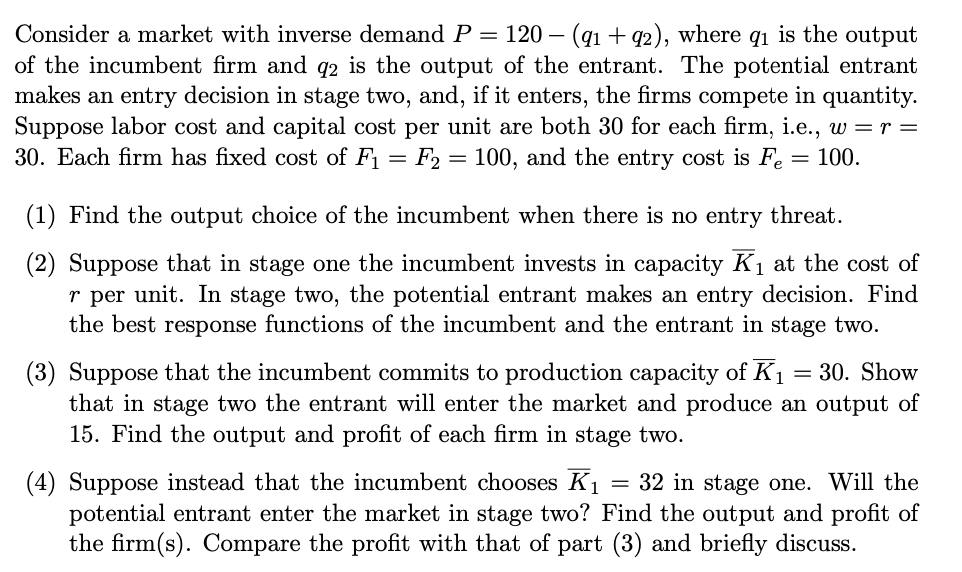Answered step by step
Verified Expert Solution
Question
1 Approved Answer
Consider a market with inverse demand P=120(q1+q2), where q1 is the output of the incumbent firm and q2 is the output of the entrant. The
 Consider a market with inverse demand P=120(q1+q2), where q1 is the output of the incumbent firm and q2 is the output of the entrant. The potential entrant makes an entry decision in stage two, and, if it enters, the firms compete in quantity. Suppose labor cost and capital cost per unit are both 30 for each firm, i.e., w=r= 30. Each firm has fixed cost of F1=F2=100, and the entry cost is Fe=100. (1) Find the output choice of the incumbent when there is no entry threat. (2) Suppose that in stage one the incumbent invests in capacity K1 at the cost of r per unit. In stage two, the potential entrant makes an entry decision. Find the best response functions of the incumbent and the entrant in stage two. (3) Suppose that the incumbent commits to production capacity of K1=30. Show that in stage two the entrant will enter the market and produce an output of 15. Find the output and profit of each firm in stage two. (4) Suppose instead that the incumbent chooses K1=32 in stage one. Will the potential entrant enter the market in stage two? Find the output and profit of the firm(s). Compare the profit with that of part (3) and briefly discuss
Consider a market with inverse demand P=120(q1+q2), where q1 is the output of the incumbent firm and q2 is the output of the entrant. The potential entrant makes an entry decision in stage two, and, if it enters, the firms compete in quantity. Suppose labor cost and capital cost per unit are both 30 for each firm, i.e., w=r= 30. Each firm has fixed cost of F1=F2=100, and the entry cost is Fe=100. (1) Find the output choice of the incumbent when there is no entry threat. (2) Suppose that in stage one the incumbent invests in capacity K1 at the cost of r per unit. In stage two, the potential entrant makes an entry decision. Find the best response functions of the incumbent and the entrant in stage two. (3) Suppose that the incumbent commits to production capacity of K1=30. Show that in stage two the entrant will enter the market and produce an output of 15. Find the output and profit of each firm in stage two. (4) Suppose instead that the incumbent chooses K1=32 in stage one. Will the potential entrant enter the market in stage two? Find the output and profit of the firm(s). Compare the profit with that of part (3) and briefly discuss Step by Step Solution
There are 3 Steps involved in it
Step: 1

Get Instant Access to Expert-Tailored Solutions
See step-by-step solutions with expert insights and AI powered tools for academic success
Step: 2

Step: 3

Ace Your Homework with AI
Get the answers you need in no time with our AI-driven, step-by-step assistance
Get Started


